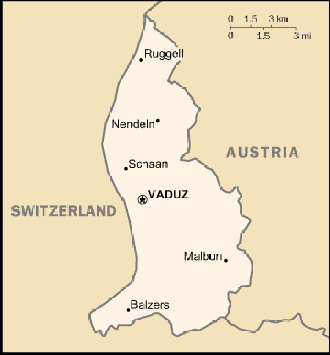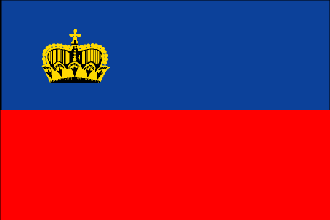
|
Liechtenstein
Background:
The Principality of Liechtenstein was established within the Holy Roman Empire
in 1719; it became a sovereign state in 1806. Until the end of World War I, it
was closely tied to Austria, but the economic devastation caused by that
conflict forced Liechtenstein to conclude a customs and monetary union with
Switzerland. Since World War II (in which Liechtenstein remained neutral) the
country's low taxes have spurred outstanding economic growth. However,
shortcomings in banking regulatory oversight have resulted in concerns about
the use of the financial institutions for money laundering.
Location:
Central Europe, between Austria and Switzerland
Area: Total: 160 sq km, water: 0 sq km, land: 160 sq km.
Area - comparative: About 0.9 times the size of Washington, DC
Land boundaries: Total: 76 km border countries: Austria 35 km, Switzerland 41
km.
Coastline: 0 km (doubly landlocked).
Climate and Terrain:
Climate: Continental; cold, cloudy winters with frequent snow or rain; cool to
moderately warm, cloudy, humid summers
Terrain: Mostly mountainous (Alps) with Rhine Valley in western third
Elevation extremes: Lowest point: Ruggeller Riet 430 m, highest point:
Grauspitz 2,599 m.
Natural resources: Hydroelectric potential, arable land.
People:
Population: 32,842.
Ethnic groups: Alemannic 87.5%, Italian, Turkish, and other 12.5%.
Religions: Roman Catholic 80%, Protestant 7.4%, unknown 7.7%, other 4.9%.
Languages: German (official), Alemannic dialect.
Government:
Government type: Hereditary constitutional monarchy.
Capital: Vaduz.
Independence: 23 January 1719.
Imperial Principality of Liechtenstein established; 12 July 1806, from the Holy
Roman Empire.
Economy overview:
Despite its small size and limited natural resources, Liechtenstein has
developed into a prosperous, highly industrialized, free-enterprise economy
with a vital financial service sector and living standards on a par with the
urban areas of its large European neighbors. Low business taxes - the maximum
tax rate is 18% - and easy incorporation rules have induced 73,700 holding or
so-called letter box companies to establish nominal offices in Liechtenstein,
providing 30% of state revenues. The country participates in a customs union
with Switzerland and uses the Swiss franc as its national currency. It imports
more than 90% of its energy requirements.
Labor force - by occupation: Industry, trade, and building 45%, services 53%,
agriculture, fishing, forestry, and horticulture 2% (1997 est.)
Industries: electronics, metal manufacturing, textiles, ceramics,
pharmaceuticals, food products, precision instruments, tourism
Statistics:
Telephones - main lines in use: 20,000.
Radio broadcast stations: AM 0, FM 4.
Radios: 21,000.
Television broadcast stations: (linked to Swiss networks).
Televisions: 12,000.
Railways: Total: 18.5 km.
Highways: Total: 250 km paved: 250 km.
Airports: None.
Return to Visiting Locations
|

